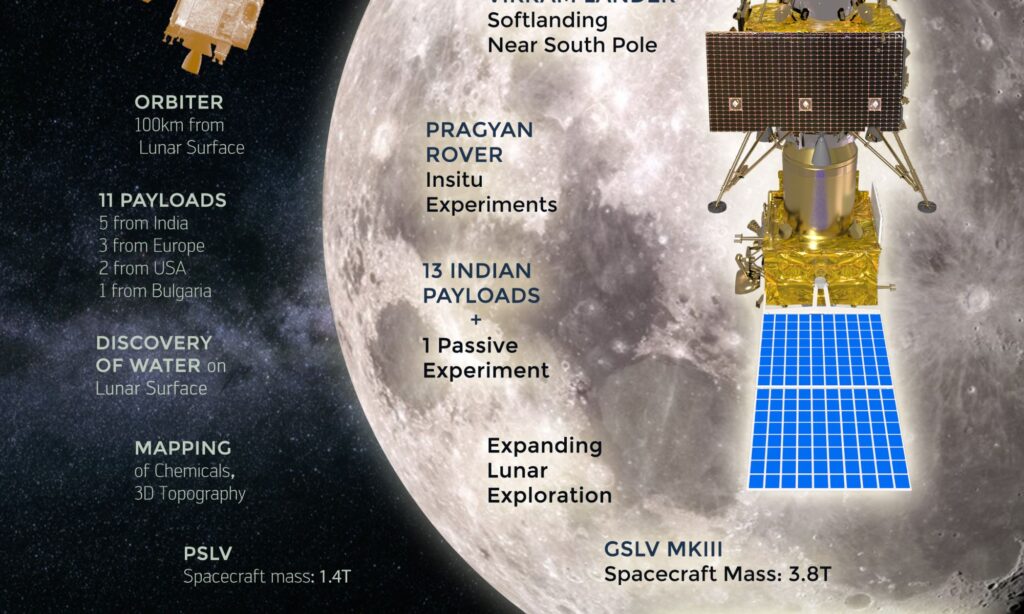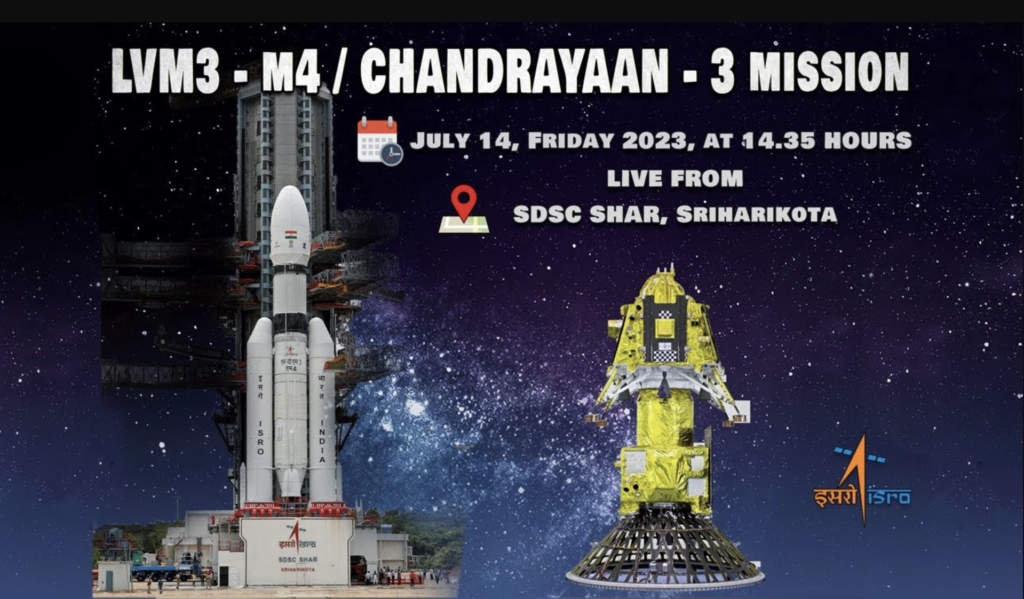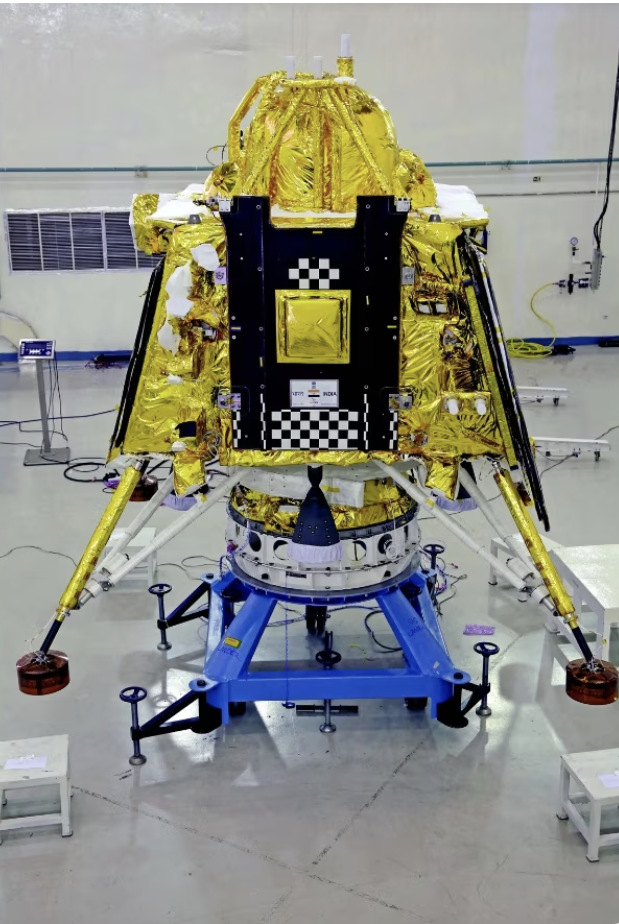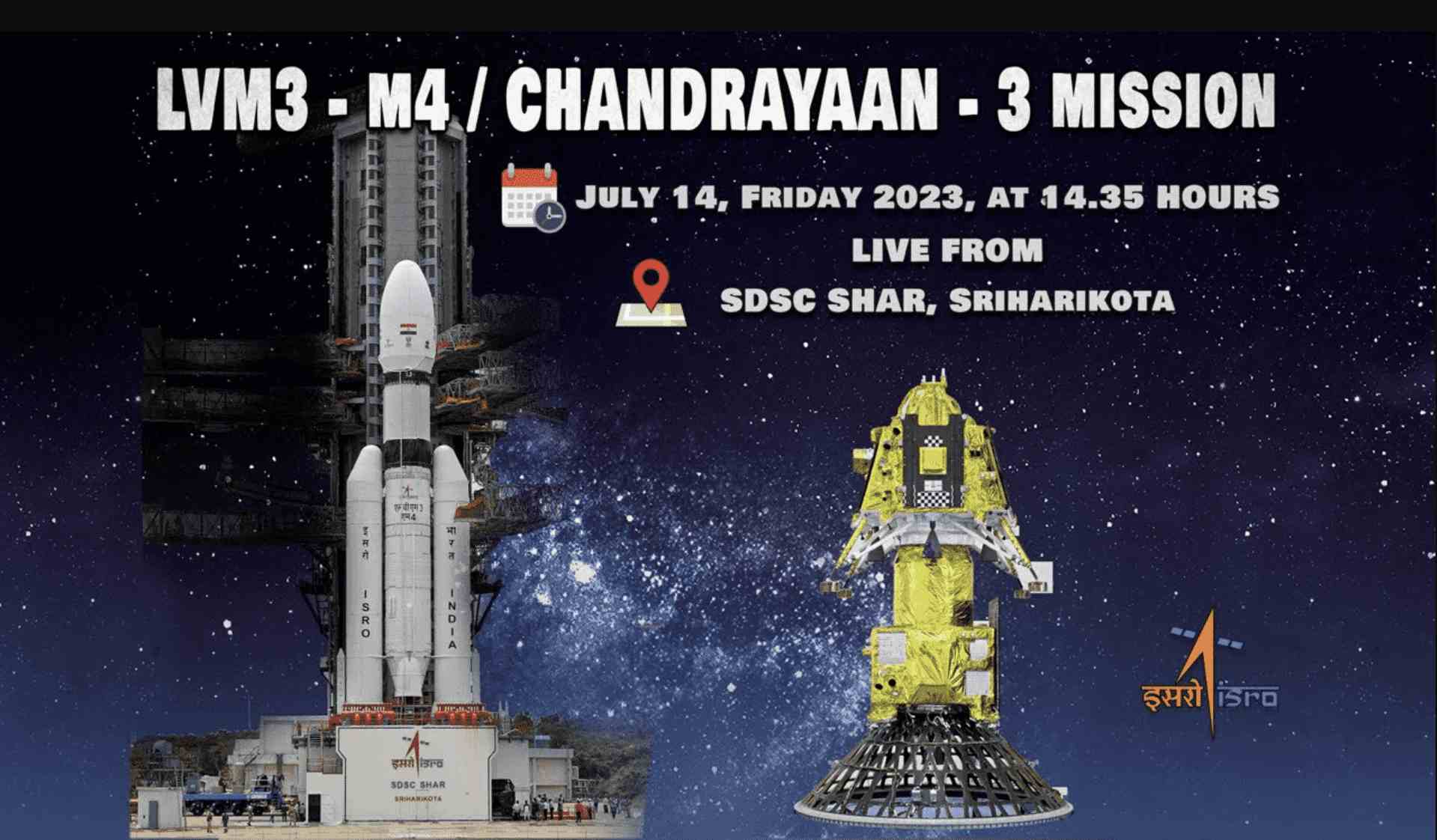Last updated on July 23rd, 2023
Introduction Chandrayaan-3
In 2008, India embarked on an ambitious mission to explore the Moon with its first lunar probe, Chandrayaan-1.
The mission was historic, making India only the fourth country to put a spacecraft into lunar orbit. Chandrayaan-1 spent nearly a year studying the lunar surface, detecting water molecules and chemicals. It was an impressive feat that cemented India’s role as an emerging space power.

Chandrayaan-1 was a major success. It achieved all of its primary objectives and made several significant discoveries, including:
- the moon’s surface having water molecules
- The existence of a new type of lunar rock
- The discovery of a large crater that may have been caused by an asteroid impact
Chandrayaan-1’s failure point was that it stopped communicating with Earth on August 28, 2009. The cause of the failure is still unknown, but it is believed to have been caused by a technical issue.
Over a decade later, India sought to take the next giant leap with its follow-up mission, Chandrayaan-2 in 2019. This time, the aim was even bolder – to soft land a rover on the Moon’s south pole and analyze its surface.
High Hopes Dashed with Chandrayaan-2’s Crash Landing
Expectations were sky-high as Chandrayaan-2 launched on July 22, 2019. Comprising an orbiter, lander and rover, it was the most complex mission ever undertaken by the Indian Space Research Organisation (ISRO).
Millions watched with bated breath as the Vikram lander separated and began its descent to the lunar surface on September 7. But in a heartbreaking setback, communication was lost just 2.1 km above the landing site.
Despite achieving 95% of objectives, the crash dashed India’s hopes of becoming the fourth nation to nail a soft landing on the Moon. It was agonizingly close yet so far for ISRO scientists who had spent years developing the mission.

Chandrayaan-2 was a partial success. The lander, Vikram, successfully touched down on the moon’s surface on September 7, 2019. However, the rover, Pragyaan, was unable to deploy due to a technical issue.
Chandrayaan-2’s failure point was the crash of the Vikram lander. The cause of the crash is still under investigation, but it is believed to have been caused by a software glitch.
India Announces Reattempt with Chandrayaan-3
However, India was not deterred by the Chandrayaan-2 setback. By November 2019, ISRO announced its intention to launch Chandrayaan-3 in 2020.
The new mission would attempt another soft landing on the Moon, demonstrating the same objectives as the previous one. It was essentially a re-do, with some changes to the spacecraft design based on lessons learned.
According to ISRO Chairman K Sivan, Chandrayaan-3 would consist of a lander and rover, but not an orbiter. Instead, it would reuse the orbiter from Chandrayaan-2 which remains operational in lunar orbit.
The mission was expected to cost around ₹250 crore, significantly lower than Chandrayaan-2’s ₹603 crore price tag. This was due to the orbiter reuse and tweaks to streamline costs.
Multiple Delays Push Chandrayaan-3 to 2023
While 2020 was set as the initial timeframe, the COVID-19 pandemic caused the first delay. Restrictions on assembling spacecraft components set Chandrayaan-3 back.
By early 2021, ISRO indicated the mission may launch sometime in late 2022. But additional factors led to pushing the timeline further.
One was Russia’s invasion of Ukraine in February 2022. This impacted procurement of payload support devices from Russia.
Additionally, technical issues with the lander necessitated design changes and reviews. More time was needed to finalize enhancements so mistakes would not be repeated.
As of mid-2023, Chandrayaan-3 is officially confirmed for launch between December 2023 and January 2024. The constant delays have been disappointing but also understandable given the complexities involved.
Mission Objectives: What’s New with Chandrayaan-3?
Chandrayaan-3’s broad objectives remain similar to Chandrayaan-2 – demonstrating India’s ability to soft-land on the lunar surface and explore it with homegrown technology.
It will build on the orbiter’s achievements by attempting to land in the same area near the Moon’s south pole. The south pole has intriguing deposits of water ice in permanently shadowed craters.
However, the lander (renamed Vikram) and rover (Pragyan) will have structural enhancements. The landing sequence software has been tweaked as well.
According to ISRO, the landing site area has also been changed to avoid problems that may have led to Vikram’s crash landing before. Extensive simulations are being used to determine optimal parameters.
Instead of the originally planned impact probe, Chandrayaan-3 may carry a seismometer to study moonquakes. This could provide insights on the lunar interior.
Its time to launch: Chandrayaan 3
The Indian Space Research Organization (ISRO)’s Chandrayaan-3 is the organization’s third lunar exploration project. The mission was launched on July 14, 2023, and successfully entered lunar orbit on August 2, 2023. The mission’s primary objective is to achieve a soft landing on the lunar surface and deploy a rover to explore the moon’s surface.

Three modules make up Chandrayaan-3: a propulsion module, a lander module, and a rover module. Carrying the lander and rover into lunar orbit is the propulsion module’s responsibility. The lander module will soft-land on the moon’s surface, and the rover will deploy from the lander and explore the lunar surface for up to two weeks.
The lander module is equipped with a variety of scientific instruments, including a camera, a spectrometer, and a magnetometer. These instruments will be used to study the moon’s surface, geology, and atmosphere. The rover is also equipped with a variety of scientific instruments, including a spectrometer, a camera, and a drill. These tools will be used to examine the makeup of the lunar rocks and soil.

In addition to its scientific objectives, Chandrayaan-3 will also test new technologies for future lunar missions. These technologies include a new lander design, a new rover design, and a new navigation system. The success of Chandrayaan-3 will help ISRO to develop the capabilities it needs to send humans to the moon in the future.
Objectives of Chandrayaan-3
The main objectives of Chandrayaan-3 are to:
- land gently on the moon’s surface
- Send a rover to the moon to explore the surface
- Investigate the environment of the moon through scientific experiments.
- Test new technologies for future lunar missions
Scientific instruments on Chandrayaan-3
The lander module on Chandrayaan-3 is equipped with the following scientific instruments:
- Terrain Mapping Camera (TMC): This camera will be used to map the lunar surface in high resolution.
- Laser Retroreflector Array (LRRR): This array of reflectors will be used to track the distance between the lander and Earth.
- Moon Mineralogy Mapper (M3): This spectrometer will be used to study the composition of the lunar surface.
- Alpha Particle X-ray Spectrometer (APXS): This spectrometer will be used to study the elemental composition of the lunar surface.
- Orbiter High Resolution Camera (OHRC): This camera will be used to take high-resolution images of the lunar surface from orbit.
The rover on Chandrayaan-3 is equipped with the following scientific instruments:
- Terrain Mapping Camera (TMC): This camera will be used to map the lunar surface in high resolution.
- Laser Induced Breakdown Spectroscopy (LIBS): This instrument will be used to study the elemental composition of the lunar surface.
- Alpha Particle X-ray Spectrometer (APXS): This spectrometer will be used to study the elemental composition of the lunar surface.
Significance of Chandrayaan-3
Chandrayaan-3 is a significant mission for ISRO and for India. The success of this mission will demonstrate India’s capabilities in lunar exploration and will help to pave the way for future lunar missions. Chandrayaan-3 will also help to advance our understanding of the moon and its history.
Future of Chandrayaan
The success of Chandrayaan-3 will help ISRO to develop the capabilities it needs to send humans to the moon in the future. ISRO is already planning a fourth lunar mission, Chandrayaan-4, which will be a human-rated mission. Chandrayaan-4 is scheduled to launch in 2024.
Conclusion
Chandrayaan-3 is a historic mission for India. The success of this mission will demonstrate India’s capabilities in lunar exploration and will help to pave the way for future lunar missions. Chandrayaan-3 will also help to advance our understanding of the moon and its history.


